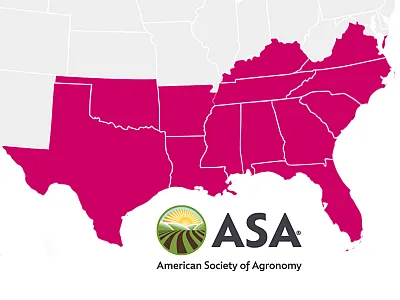Lygus Bug and Alfalfa Weevil Insecticide Resistance in the Pacific Northwest
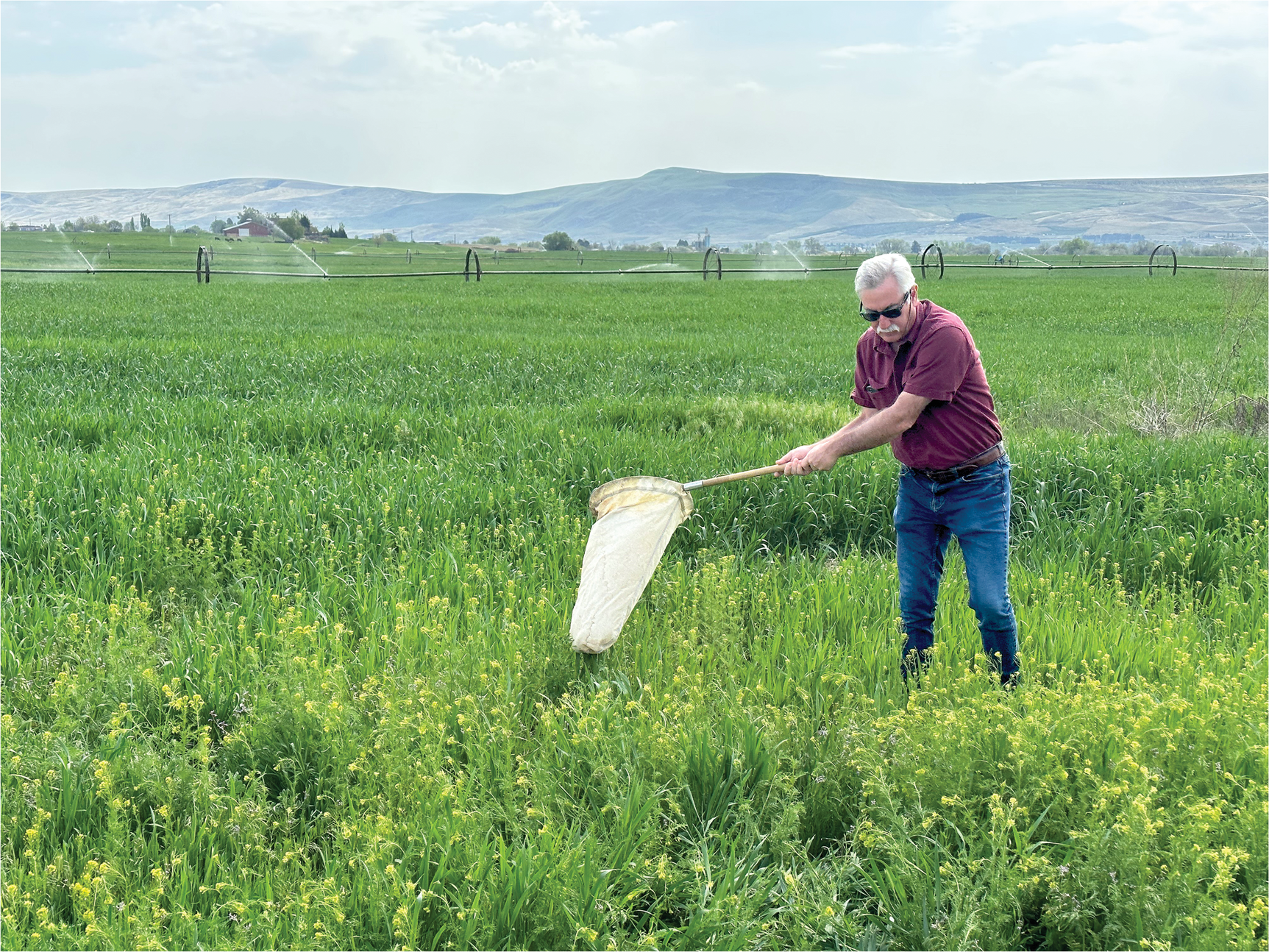
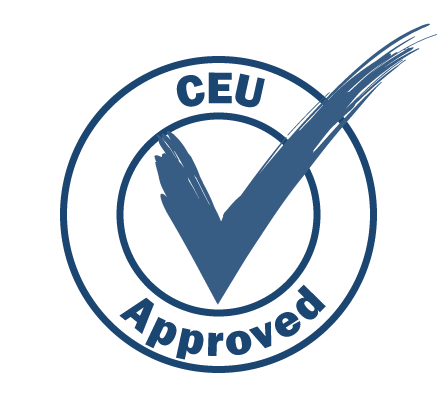
In Washington State, east of the Cascade Mountains, alfalfa is grown for seed and forage. Alfalfa weevils are the primary defoliators of alfalfa grown for forage and seed, and Lygus bugs are the key direct pest in alfalfa seed production in the Pacific Northwest. Both alfalfa weevil and Lygus bugs are controlled by insecticide applications. Some levels of insecticide resistance have been observed in recent years. This article reports on a series of experiments that were conducted to quantify the resistance status of Lygus bugs and alfalfa weevils to several insecticides in Washington State. Earn 1.5 CEUs in Integrated Pest Management by reading this article and taking the quiz.
The Pacific Northwest is divided by the Cascade Mountain Range. The west side of the Cascade Range receives abundant rainfall (>40 inches annually), and winter and summer temperatures are moderated by proximity to the Pacific Ocean. Areas east of the Cascade Mountain Range are covered by a rain shadow that is created by the mountains. This primarily semi‐arid landscape can receive as little as 3 inches of rainfall in some locations. However, rainfall typically increases with increased distance east from the mountains. Some areas in eastern Washington State and western Idaho can receive up to 30 inches of rainfall.
Washington State produced approximately $9 billion in agricultural products in 2020. Roughly 80% of the agricultural production is in the semi‐arid regions of eastern Washington State. With the exception of dry beans, lentils, and some grain crops (wheat and barley), most of the agricultural production east of the Cascade mountains depends on irrigation. It is within these areas that alfalfa grown for seed and forage are produced. Alfalfa weevils (Hypera postica) are the primary defoliators of alfalfa grown for forage and seed, and Lygus bugs (Lygus hesperus and L. elisus) are the key direct pest in alfalfa seed production in the Pacific Northwest.
Alfalfa weevils overwinter as adults in field trash or other secluded hiding places and emerge in late winter or early spring. Soon after emergence and mating, the adult females begin inserting their eggs into the alfalfa stems. Hatching larvae make their way up the stem to feed on alfalfa terminals and drop to spin a cocoon and pupate by early summer. In the Pacific Northwest, alfalfa weevil generally has only one generation a year. Young larvae damage alfalfa by feeding on terminal buds; larger larvae feed on the leaflets. Feeding by older larvae is the most damaging and is characterized as skeletonization and bronzing of the leaves in spring. Under severe pressure from high populations, alfalfa weevil can completely defoliate alfalfa fields.
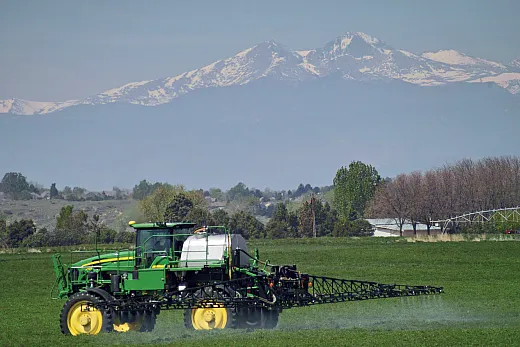
Lygus bugs overwinter as adults in alfalfa fields and weedy areas and complete two to three generations per season. As springtime temperatures warm and weedy patches dry down, adults migrate into irrigated areas, most notably alfalfa fields. In forage alfalfa, Lygus bugs are basically a nuisance pest. When alfalfa forage fields are swathed, there is typically a substantial migration of flying Lygus bug adults into nearby crops. Forage alfalfa fields can be swathed as few as two times per season and as many as four to five times per growing season depending on location and growing conditions. Alfalfa grown for seed is not swathed. It is desiccated with a burndown herbicide prior to harvest and then combine‐harvested. Fields of alfalfa grown for seed go into bloom typically in early June; bloom is indeterminate and bloom and subsequently seed set will continue into mid‐July. Lygus bug adults and nymphs attack the developing seed pods, and the Lygus bugs feeding with their piercing sucking mouthparts “blast” the alfalfa seeds in the developing seed pod. If left uncontrolled, the seed crop loss from Lygus bug feeding can approach 100%.
Both alfalfa weevil and Lygus bugs are controlled by insecticide applications. In forage alfalfa and pre‐ and post‐bloom fields of alfalfa grown for seed, this has been achieved with applications of organophosphate, pyrethroid, or premix insecticides combining mixtures of both. Indoxacarb has been registered for use on alfalfa weevil, and flonicamid and sulfoxaflor are registered for use on alfalfa grown for seed. Sulfoxaflor is registered on alfalfa via a Section 3 label for Transform from Corteva Agrisciences, and flonicamid is registered in most western alfalfa seed‐producing states by a 24C Special Local Need registration for Beleaf from FMC. We have observed some levels of insecticide resistance primarily to the pyrethroid insecticides in populations of both the alfalfa weevil and Lygus bugs in recent years. We believe that this process may accelerate with the recent revocation for the food tolerance for chlorpyrifos on alfalfa forage. Alfalfa growers will become more reliant on inexpensive pyrethroid insecticides going forward from here.
Most notably, alfalfa forage growers in Klickitat County, WA had reported field failures with the formulated pre‐mix insecticide Cobalt in 2018. Cobalt was an insecticide marketed by Corteva Agrisciences and was a mixture of the organophosphate insecticide chlorpyrifos (aka Lorsban Advanced) and the synthetic pyrethroid lambda‐cyhalothrin (aka Warrior). Field failures were not unique to a single grower. In response, we completed laboratory bioassays that concluded that alfalfa weevils were resistant to the pyrethroid lambda‐cyhalothrin in the Goldendale area but not in other areas we tested for resistance, including Othello, Prosser, and Touchet, WA. Managing pyrethroid resistance has become increasingly important given the chlorpyrifos tolerance revocation for forage alfalfa.
Experiment Setup to Quantify Resistance
In 2020 and 2021, we completed a series of experiments to quantify the resistance status of Lygus bugs and alfalfa weevils to several insecticides. In 2020, we completed 32 sets of bioassays of the response Lygus bug populations had to the insecticide bifenthin. With lambda‐cyhalothrin, we competed 31 sets of bioassays. With sulfoxaflor, we completed 29 sets of bioassays. The Lygus bugs tested were collected from 10 distinct geographic regions, including, Othello, Prosser, Horse Heaven Hills, Touchet, Gardena, Lowden, North Pasco, Ash, and Prescott, WA.
In 2021, alfalfa weevil larva populations were collected from alfalfa forage near Goldendale, Othello, Gardena, and Prosser, WA. The four insecticides tested included the registered products Warrior II (lambda‐cyhalothrin), Mustang Maxx (zeta‐cypermethrin), Baythroid (beta‐cyfluthrin), and Lorsban Advanced (chlorpyrifos).
Lygus Bugs 2020
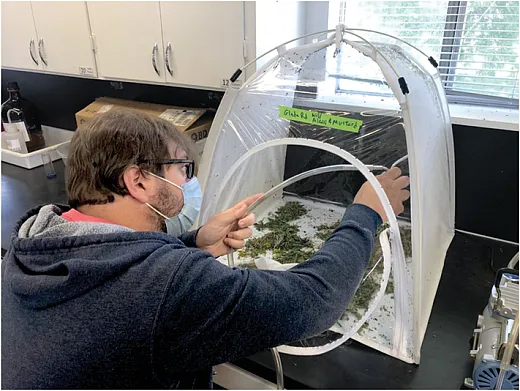
Lygus bugs were collected by sweep net and placed in a bug dorm (BioQuip, Inc.) and transported to the Environmental and Agricultural Entomology Laboratory located at Washington State University’s (WSU) Irrigated Agriculture Research and Extension Center near Prosser, WA. The Lygus bugs were provided with organically produced green beans for sustenance and held overnight. They were then aspirated into small snap‐top plastic vials in aliquots of approximately 10 adults and held for approximately 15 minutes. The Lygus bugs were then anesthetized with CO2 and placed in a petri dish with a piece of filter paper on the base. These individual cohorts of approximately 10 Lygus bugs per petri dish were then subjected to increasing doses of each insecticide in our Potter precision spray tower in dilutions equivalent to 20 gal/ac.
The rates for bifenthrin were 0, 1, 5, 10, and 50% of the maximum labeled field rate of 0.1 lb of active ingredient per acre for bifenthin. The rates for Lambda‐cyhalothrin were 0, 1, 10, 20, and 50% of the labeled field rate of 0.03 lb of active ingredient for lambda‐cyhalothrin. The rates for sulfoxaflor were 0, 1, 5, 10, and 20% of the labeled field rate of 0.071 lb of active ingredient per acre for sulfoxaflor. Each dilution rate for all three insecticides was replicated three times on cohorts of approximately 10 Lygus bugs per Petri dish. The Lygus bugs were provided with a 3 cm piece of green bean and held overnight and assessed for mortality at 24 hours after treatment. For analysis in PoloPLus, dose is converted into parts per million. Mortality is corrected in the serial dilutions against the water control treatment by Abbot’s formula, and the data are run through PoloPlus to calculate LD50 and LD90 values. These values represent the concentration of each insecticide required to kill 50 and 90% of each tested population, respectively.
Alfalfa Weevils 2021
To quantify the dose response of alfalfa weevil populations in Washington State, alfalfa weevil larva were collected at four locations in Washington State and transported back to the Environmental and Agricultural Entomology Laboratory at WSU Prosser. These weevils were then subjected to dose response bioassay via our Potter precision spray tower. Larva populations were collected from sites including an alfalfa forage field in Goldendale, an alfalfa field at WSU Othello, an alfalfa field near Gardena, and an alfalfa field at WSU IAREC. The four insecticides tested included the registered products Warrior II (lambda‐cyhalothrin), Mustang Maxx (zeta‐cypermethrin), Baythroid (beta‐cyfluthrin), and Lorsban Advanced (chlorpyrifos).
Serial dilutions were completed for each insecticide in a dilution equivalent to 20 gal/ac at 100, 75, 50, 25, 10, 5, and 0% of the maximum field rate for Lorsban Advanced and Warrior II and 75, 50, 25, 10, 5, and 0% of the maximum field rate for Mustang Maxx and Baythroid. Each treatment was applied to four replicates of five weevil grubs in a Petri dish with a filter paper bottom in 2 mL of solution in our Potter precision spray tower. The weevil larva were evaluated at 24 and 48 hours after treatment for mortality and survivorship. Subsequently, our data evaluations were completed on the weevil morality after 48 hours of exposure due to greater consistency of results. Weevil larva were considered dead when they failed to respond to being touched with a fine camel hair brush.
Experiment Results
Lygus Bugs 2020
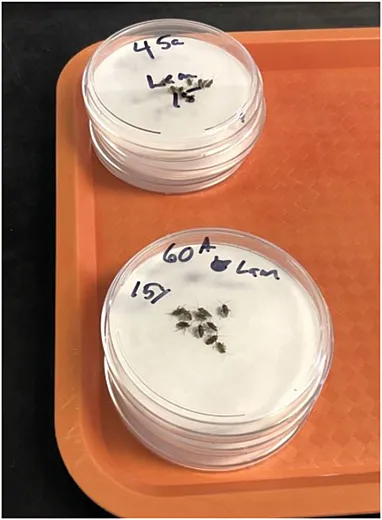
Table 1 provides the geographic region, GPS coordinates, host plant (Crop) the Lygus population was captured from, and the day the Lygus were exposed to bifenthrin. Also detailed are the PoloPlus‐calculated LD50 and LD90 concentrations for each Lygus population. Empty cells in the data for LD50 and LD90 are where PoloPlus failed to calculate values where the tested rates were either too high or low. Similar information is provided in Tables 2 and 3 for the insecticides lambda‐cyhalothrin and sulfoxaflor, respectively.
| Location | Crop | GPS | Spray Date | LD50 | LD90 |
|---|---|---|---|---|---|
| Ash | forage alfalfa | 46.2470656, -118.8181542 | 7/21/2020 | 30.97 | 206.14 |
| Gardena | forage alfalfa | 46.006523, -118.703113 | 6/4/2020 | 22.72 | 184.54 |
| Gardena | forage alfalfa | 46.006523, -118.703113 | 7/14/2020 | 33.8 | 270.17 |
| Gardena | forage alfalfa | 46.006523, -118.703113 | 7/21/2020 | 62.72 | 320.34 |
| Gardena | forage alfalfa | 46.006523, -118.703113 | 8/6/2020 | 54.95 | 250.78 |
| Gardena | forage alfalfa | 46.006523, -118.703113 | 9/14/2020 | 11.65 | 98.77 |
| Gardena | Seed alfalfa | 46.006406, -118.700049 | 6/23/2020 | Did not calculate | |
| Gardena | Seed alfalfa | 46.006406, -118.700049 | 6/23/2020 | 38.5 | 168.99 |
| Horse Heaven Hills | Mustards | 46.109963, -119.552128 | 6/23/2020 | 9.833 | 68.6 |
| Horse Heaven Hills | Mustards | 46.0088121, -119.602416 | 7/1/2020 | 13.217 | 123.16 |
| Horse Heaven Hills | Mustards | 46.0088121, -119.602416 | 7/9/2020 | 11.5 | 69.1 |
| IAREC HQ | forage alfalfa | 46.252283, -119.730591 | 7/24/2020 | 34.36 | 231.17 |
| IAREC HQ | forage alfalfa | 46.252283, -119.730591 | 8/4/2020 | 84.04 | 231.76 |
| N. Pasco | Unmanaged alfalfa | 46.401755, -119.113827 | 6/2/2020 | 139.3 | 752.2 |
| North Pasco | forage alfalfa | 46.495270, -119.132557 | 6/23/2020 | 52.75 | 256.59 |
| North Pasco | forage alfalfa | 46.394354, -119.114806 | 6/23/2020 | 27.63 | 71.38 |
| North Pasco | Unmanaged alfalfa | 46.401755, -119.113827 | 6/23/2020 | Did not calculate | |
| Othello | Mustard | 46.785968, -119.037370 | 6/2/2020 | 44.5 | 333.9 |
| Prescott (potato 1) | Potato (Russian thistle) | 46.2958101, -118.6351347 | 8/13/2020 | Did not calculate – high mortality at >5% | |
| Prescott (potato 2) | Potato (Russian Thistle) | 46.2943734, -118.7015200 | 8/13/2020 | 21.98 | 88.74 |
| Prosser | Alfalfa | 46.239924, -119.789354 | 5/21/2020 | 25.8 | 198.7 |
| Roza | Alfalfa | 46.785968, -119.037370 | 5/27/2020 | 91.4 | 412.1 |
| Roza | forage alfalfa | 46.785968, -119.037370 | 6/19/2020 | 51.89 | 196.85 |
| Roza | forage alfalfa | 46.785968, -119.037370 | 7/9/2020 | 41.9 | 500.3 |
| Roza | forage alfalfa | 46.785968, -119.037370 | 7/24/2020 | 62.05 | 156.23 |
| Roza | forage alfalfa | 46.785968, -119.037370 | 8/4/2020 | Did not calculate – low mortality <10% | |
| Roza | forage alfalfa | 46.785968, -119.037370 | 8/18/2020 | 16.8 | 76.32 |
| Roza | Mustard | 46.296866, -119.746376 | 5/19/2020 | Rates too low | |
| Roza | Mustard | 46.296866, -119.746376 | 5/27/2020 | 28.2 | 117.8 |
| Roza | Mustard | 46.296866, -119.746376 | 6/19/2020 | 18.57 | 66.46 |
| Touchet | Mustard | 46.041504, -118.652145 | 6/4/2020 | 52.25 | 327 |
Note. LD50 and LD90 values represent the concentration of each insecticide required to kill 50 and 90% of each tested population, respectively.
| Location | Crop | GPS | Spray Date | LD50 | LD90 |
|---|---|---|---|---|---|
| Ash | Forage alfalfa | 46.2470656, -118.8181542 | 7/21/2020 | 214.41 | 748.51 |
| Gardena | Forage alfalfa | 46.006523, -118.703113 | 6/4/2020 | 73.2 | 1014.2 |
| Gardena | Forage alfalfa | 46.006523, -118.703113 | 7/21/2020 | 272.9 | 684.91 |
| Gardena | Forage alfalfa | 46.006523, -118.703113 | 8/6/2020 | 176.37 | 2008.2 |
| Gardena | Forage alfalfa | 46.006523, -118.703113 | 9/14/2020 | 80.85 | 379.95 |
| Gardena | Seed alfalfa | 46.006406, -118.700049 | 6/23/2020 | Did not calculate | |
| Gardena | Seed alfalfa | 46.006406, -118.700049 | 6/23/2020 | 194.78 | 713.53 |
| Horse Heaven Hills | Mustards | 46.109963, -119.552128 | 6/23/2020 | Very susceptible | |
| Horse Heaven Hills | Mustards | 46.0088121, -119.602416 | 7/1/2020 | 30.5 | 180.28 |
| Horse Heaven Hills | Mustards | 46.0088121, -119.602416 | 7/9/2020 | 56 | 360 |
| IAREC HQ | Forage alfalfa | 46.252283, -119.730591 | 7/24/2020 | 142.9 | 887.99 |
| IAREC HQ | Forage alfalfa | 46.252283, -119.730591 | 8/4/2020 | 297.93 | 1179.75 |
| N. Pasco | Unmanaged alfalfa | 46.401755, -119.113827 | 6/2/2020 | Rates too low | |
| North Pasco | Forage alfalfa | 46.495270, -119.132557 | 6/23/2020 | Did not calculate | |
| North Pasco | Forage alfalfa | 46.394354, -119.114806 | 6/23/2020 | Did not calculate | |
| North Pasco | Unmanaged alfalfa | 46.401755, -119.113827 | 6/23/2020 | 286.54 | 2365 |
| Othello | Mustard | 46.785968, -119.037370 | 6/2/2020 | 147.2 | 1137.8 |
| Prescott (potato 1) | Potato (Russian thistle) | 46.2958101, -118.6351347 | 8/13/2020 | 98.04 | 428.72 |
| Prescott (potato 2) | Potato (Russian thistle) | 46.2943734, -118.7015200 | 8/13/2020 | 78.73 | 526.34 |
| Prosser | Alfalfa | 46.239924, -119.789354 | 5/21/2020 | 16.8 | 347.3 |
| Roza | Alfalfa | 46.785968, -119.037370 | 5/27/2020 | Rates not good | |
| Roza | Forage alfalfa | 46.785968, -119.037370 | 6/19/2020 | 188.38 | 700.48 |
| Roza | Forage alfalfa | 46.785968, -119.037370 | 7/24/2020 | 171.62 | 1029.9 |
| Roza | Forage alfalfa | 46.785968, -119.037370 | 8/4/2020 | 156.96 | 563.88 |
| Roza | Forage alfalfa | 46.785968, -119.037370 | 8/18/2020 | 206.75 | 1903.4 |
| Roza | Mustard | 46.296866, -119.746376 | 5/19/2020 | Rates too low | |
| Roza | Mustard | 46.296866, -119.746376 | 5/27/2020 | Rates too high | |
| Roza | Mustard | 46.296866, -119.746376 | 6/19/2020 | 43.75 | 255.14 |
| Touchet | Mustard | 46.041504, -118.652145 | 6/4/2020 | 96.5 | 1165.5 |
Note. LD50 and LD90 values represent the concentration of each insecticide required to kill 50 and 90% of each tested population, respectively.
| Location | Crop | GPS | Spray Date | LD50 | LD90 |
|---|---|---|---|---|---|
| Ash | Forage alfalfa | 46.2470656, -118.8181542 | 7/21/2020 | 9.19 | 59.3 |
| Gardena | Forage alfalfa | 46.006523, -118.703113 | 6/4/2020 | 13.14 | 33.49 |
| Gardena | Forage alfalfa | 46.006523, -118.703113 | 7/21/2020 | 16.74 | 30.8 |
| Gardena | Forage alfalfa | 46.006523, -118.703113 | 8/6/2020 | 15.97 | 39.86 |
| Gardena | Forage alfalfa | 46.006523, -118.703113 | 9/14/2020 | 9.03 | 29.82 |
| Gardena | Seed alfalfa | 46.006406, -118.700049 | 6/23/2020 | 21.47 | 60.61 |
| Gardena | Seed alfalfa | 46.006406, -118.700049 | 6/23/2020 | 15.41 | 39.47 |
| Horse Heaven Hills | Mustards | 46.109963, -119.552128 | 6/23/2020 | 7.463 | 24.451 |
| Horse Heaven Hills | Mustards | 46.0088121, -119.602416 | 7/1/2020 | Did not calculate | |
| Horse Heaven Hills | Mustards | 46.0088121, -119.602416 | 7/9/2020 | 24.14 | 59.76 |
| IAREC HQ | Forage alfalfa | 46.252283, -119.730591 | 7/24/2020 | 13.01 | 34.22 |
| IAREC HQ | Forage alfalfa | 46.252283, -119.730591 | 8/4/2020 | Did not calculate – high mortality >5% | |
| N. Pasco | Unmanaged alfalfa | 46.401755, -119.113827 | 6/2/2020 | 55.3 | 128 |
| North Pasco | Forage alfalfa | 46.495270, -119.132557 | 6/23/2020 | 7.18 | 18.3 |
| North Pasco | Forage alfalfa | 46.394354, -119.114806 | 6/23/2020 | 7.89 | 15.44 |
| North Pasco | Unmanaged alfalfa | 46.401755, -119.113827 | 6/23/2020 | 19.39 | 46.06 |
| Othello | Mustard | 46.785968, -119.037370 | 6/2/2020 | 10.98 | 28.75 |
| Prescott (potato 1) | Potato (Russian thistle) | 46.2958101, -118.6351347 | 8/13/2020 | 13.23 | 48.96 |
| Prescott (potato 2) | Potato (Russian thistle) | 46.2943734, -118.7015200 | 8/13/2020 | 9.72 | 32.05 |
| Prosser | Alfalfa | 46.239924, -119.789354 | 5/21/2020 | Rates too low | |
| Roza | Alfalfa | 46.785968, -119.037370 | 5/27/2020 | 39.6 | 253.4 |
| Roza | Forage alfalfa | 46.785968, -119.037370 | 6/19/2020 | 11.23 | 25.87 |
| Roza | Forage alfalfa | 46.785968, -119.037370 | 7/24/2020 | Not calculated – high mortality >5% | |
| Roza | Forage alfalfa | 46.785968, -119.037370 | 8/4/2020 | Did not calculate – high mortality >5% | |
| Roza | Forage alfalfa | 46.785968, -119.037370 | 8/18/2020 | 6.38 | 21.61 |
| Roza | Mustard | 46.296866, -119.746376 | 5/27/2020 | 16.1 | 65.09 |
| Roza | Mustard | 46.296866, -119.746376 | 6/19/2020 | 11.6 | 28.49 |
| Touchet | Mustard | 46.041504, -118.652145 | 6/4/2020 | 16.42 | 62.75 |
Note. LD50 and LD90 values represent the concentration of each insecticide required to kill 50 and 90% of each tested population, respectively.
The field rate of bifenthrin at 0.10 lb of active ingredient diluted in the equivalent of 20 gal/ac converts to 599 ppm. The greatest value for a LD90 was observed in an unmanaged alfalfa field in North Pasco. The LD90 was 752.2 ppm. The Lygus in this site were certainly tolerant to bifenthrin, but we do not think that this population was truly resistant to bifenthrin. Many of the populations were very susceptible to being killed by bifenthrin. Several of the locations/populations were sampled multiple times. The forage alfalfa location in Gardena was in close proximity to alfalfa produced for seed. The LD90 values in this location were fairly consistent among the sampling dates and dropped down quite a bit in September. Overall, the Lygus bugs that were tested among multiple crops/host plants across a large geography in the Columbia Basin of Washington State were not resistant to bifenthrin.
The field rate of lambda‐cyhalothrin at 0.03 lb of active ingredient diluted in the equivalent of 20 gal/ac converts to 1,875 ppm. The greatest value for a LD90 (2,365 ppm) was observed in a unmanaged alfalfa field in North Pasco. However, there were a greater number of locations including the alfalfa forage field near Gardena and the alfalfa forage field on the Roza site that exhibited greater tolerance in early August than on any other dates that these sites were sampled. The LD90 values were around 1,900 to 2,000 ppm. There were many sites in which the Lygus bugs were very susceptible to being killed by lambda‐cyhalothrin at recommended field rates. However, it appears that between the two pyrethroids, bifenthrin and lambda‐cyhalothrin, the Lygus in general are more tolerant to lambda‐cyhalothrin. Lambda‐cyhalothrin has been used extensively in the past on forage alfalfa and alfalfa grown for seed. Bifenthrin is not registered for use on forage alfalfa. Rather it is registered under a 24C Special Local Need registration in most western alfalfa seed growing states. This may be the reason we observed differences in the susceptibilities in several Lygus populations to lambda‐cyhalothrin versus bifenthrin.
The field rate of sulfoxaflor at 0.071 lb of active ingredient diluted in the equivalent of 20 gal/ac converts to 406 ppm. The greatest LD90, 253.4, was observed in a Lygus bug population collected from forage alfalfa on the WSU Roza site. This was an anomaly because the next greatest LD90 was in Gardena from a field of alfalfa produced for seed at 60.61. This seed field had been treated one to two times per growing season for the past five years with sulfoxaflor. These results provide a good snapshot for the relative susceptibility of Lygus bugs in south‐central Washington State to sulfoxaflor at an early period of its registration. We can check periodically in future years to quantify whether Lygus are gaining tolerance to sulfoxaflor.
Alfalfa Weevils 2021
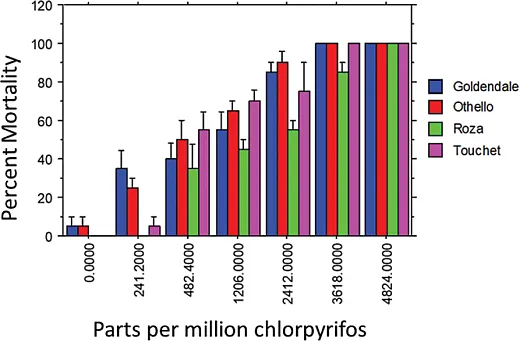
Among all the four populations tested against the organophosphate chlorpyrifos and the three synthetic pyrethroids, only the Goldendale population exhibited resistance to lambda‐cyhalothrin, and the Roza population exhibited some resistance to chlorpyrifos (Figures 1–4). The revocation of chlorpyrifos for alfalfa weevil control will only put increased pressure on the synthetic pyrethroids and increase the likelihood of resistance developing to the pyrethroids.
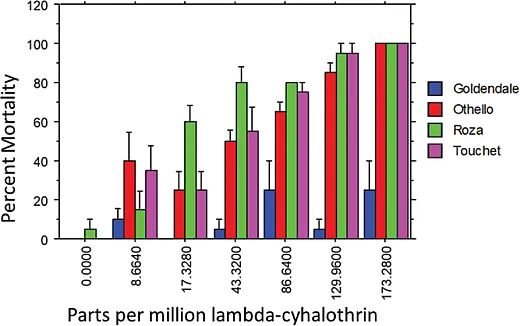
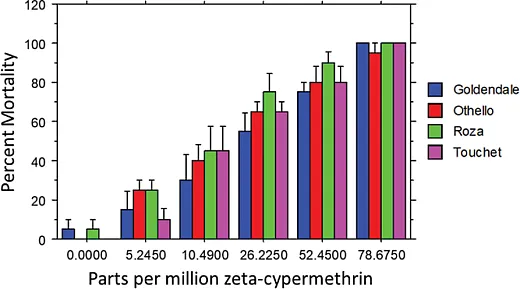
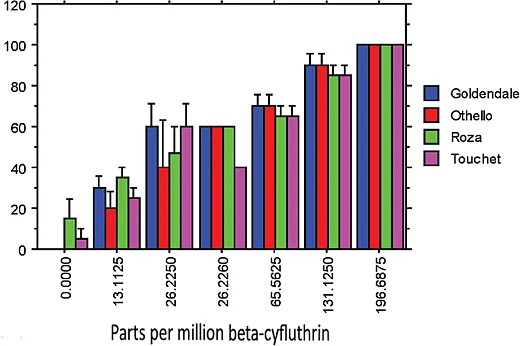
Conclusion
Insecticide resistance management should be a strategy employed while controlling Lygus bugs in alfalfa grown for seed and for alfalfa weevils in both alfalfa forage and seed production. Actual resistance of Lygus bugs to the two pyrethroid insecticides, bifenthrin and lambda‐cyhalothrin, that were tested was not truly observed. Sulfoxaflor has only been on the market for approximately 10 years, and most alfalfa seed growers limit themselves to a single application. Sulfoxaflor is registered on forage alfalfa, but it has not gained much market share due to its greater cost than the pyrethroids and organophosphates that have historically been registered on alfalfa.
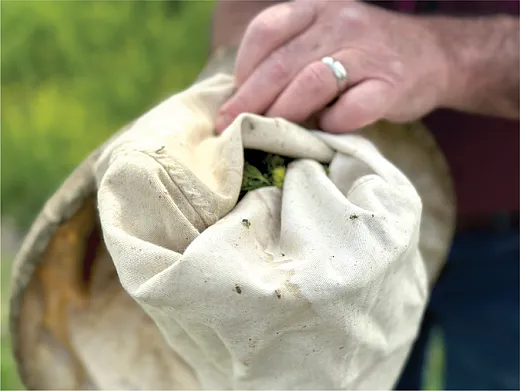
Although technically the same crops, forage alfalfa and alfalfa grown for seed employ significantly different management production and pest management practices. Alfalfa seed production in Washington State is centered on a relatively small and uniform cohort of growers located in Walla Walla County centered around the communities of Touchet and Lowden. Alfalfa seed growers produce seed under direct contract to genetic providers (seed companies) on typically a three‐year rotation. Managed pollinators, including alfalfa leafcutting bee and alkali bee, are integral to alfalfa seed production. Alfalfa seed growers are very judicious in their use of pesticides, including insecticides during bloom when bees are actively foraging. They limit the use of broad‐spectrum insecticides to periods pre‐ and post‐bloom and only apply insecticides that have been deemed to be relatively safe for foraging bees through bioassay. During bloom, most pesticides are applied between dusk and midnight.

Forage alfalfa in Washington State varies substantially among growers. There are a number of small‐scale alfalfa growers who will grow and bale hay for direct sale to owners of livestock. Many will grow alfalfa directly on‐farm for direct feed to on‐farm livestock. There is a substantial amount of alfalfa hay grown directly by large‐scale dairy producers for livestock feed. Then there are large‐scale alfalfa hay producers who can grow thousands of acres for export and large‐scale dairies and feedlots. Consequently, there is great variability among this range of producers in their pest management practices. This is manifested in our studies by our observing the greatest level of pyrethroid resistance in alfalfa weevil populations on small‐scale farms where the hay is often direct‐fed to the hay producers’ livestock on farm. In these situations, the growers are seeking the least expensive control for weevils in the springtime. This historically has been a pyrethroid, or a premix insecticide containing a pyrethroid and an organophosphate.
Prior to the revocation of the food tolerance for chlorpyrifos, many of these small‐scale alfalfa hay producers applied one of several commercial formulations that contained chlorpyrifos and lambda‐cyhalothrin. Proper practices of rotating insecticide chemistries are not followed as access to Extension professionals and pest management education can be limited in these rural communities. The larger commercial‐scale forage alfalfa growers have greater access to Extension educators and pest management education as well as commercial pest management professionals for advice. Insecticide mode of action is considered when making pest management decisions, and insecticide chemistries are often rotated as recommended on most insecticides to limit the development of resistance.
Chlorpyrifos was an important insecticide for control of both Lygus bugs and alfalfa weevil production. The revocation of the tolerance for chlorpyrifos on forage alfalfa will likely increase reliance by cost‐conscious forage alfalfa growers on inexpensive pyrethroid insecticides, which may unfortunately hasten increased resistance of pest insects, including alfalfa weevils, to pyrethroid insecticides.
Self-Study CEU Quiz
Earn 1.5 CEUs in Integrated Pest Management by taking the quiz. For your convenience, the quiz is printed below. The CEU can be purchased individually, or you can access as part of your Online Classroom Subscription.
- In Washington State, alfalfa grown for seed and forage alfalfa are produced west of the Cascade Mountains.
- True.
- False.
- Because they are technically the same crop, forage alfalfa and alfalfa grown for seed are managed in similar ways.
- True.
- False.
- How do alfalfa weevils get onto the alfalfa plant?
- Females deposit eggs at the base of the plant.
- Females deposit eggs on the undersides of leaves.
- Females insert eggs into the stems.
- All of the above.
- Which of the following statements is true of young alfalfa weevil larvae?
- They damage alfalfa by feeding on leaflets.
- They damage alfalfa by feeding on the terminal buds.
- Their feeding is characterized as skeletonization of the leaves.
- Their feeding is characterized as bronzing of the leaves.
- How many generations do Lygus bugs complete per season?
- One.
- One to two.
- Two to three.
- Four.
- Lygus bugs are nuisance pests in forage alfalfa, but in seed alfalfa, they can damage up to ______ of the crop.
- 100%
- 85%
- 60%
- 50%
- In 2018, alfalfa forage growers in which county in Washington State reported field failures after using the insecticide Cobalt?
- Adams County.
- Benton County.
- Klickitat County.
- Walla Walla County.
- The authors tested the effect of two pyrethroids, bifenthrin and lambda-cyhalothrin, on Lygus bugs and found the pests were more tolerant of the latter.
- True.
- False.
- Lygus bugs in south-central Washington State have grown tolerant of the insecticide sulfoxaflor.
- True.
- False.
- The authors tested how four populations of alfalfa weevils fared against three synthetic pyrethroids and chlorpyrifos, an organophosphate. How many of the populations exhibited resistance to the pyrethroid lambda-cyhalothrin?
- One.
- Two.
- Three.
- All of them.
- Why are alfalfa seed growers more judicious about applying pesticides than forage growers?
- Pesticides are less effective on alfalfa grown for seed.
- Farmers don’t want to harm pollinators required for production.
- Pesticides can harm alfalfa grown for seed during bloom.
- None of the above.
- Why are more forage alfalfa growers using pyrethroid insecticides?
- Because of the revocation of the food tolerance for chlorpyrifos.
- Because it is relatively inexpensive.
- Neither a nor b.
- Both a and b.
- The growing use of pyrethroid insecticides could result in alfalfa weevils becoming resistant to it faster.
- True.
- False.
- Small-scale alfalfa farms where the hay is often direct-fed to the producers’ livestock on farm tend to experience more pyrethroid resistance in alfalfa weevil populations than larger commercial-scale forage alfalfa farms.
- True.
- False.
- Some alfalfa farmers don’t always implement the best practice of rotating insecticides. According to the authors, what is one reason explaining that?
- Farmers tend to continue using what has worked in previous years.
- Many rural farmers lack easy access to Extension professionals and education.
- Farmers can’t afford the time and money associated with implementing new practices.
- Farmers put more trust in what their neighbors are doing than in what Extension offices are recommending.
Text © . The authors. CC BY-NC-ND 4.0. Except where otherwise noted, images are subject to copyright. Any reuse without express permission from the copyright owner is prohibited.




